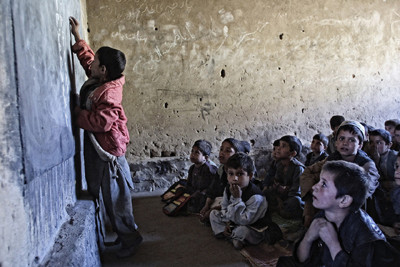By Kristina Wong
A $3 million U.S.-contracted schools project in Afghanistan remains grossly unfinished more than four years after the start of construction because the Army Corps of Engineers did not hold the contractor accountable for the work it has been paid to do, a new report by a U.S. government watchdog says.
“This raises concerns because we have previously reported instances in which [the Corps of Engineers] failed to hold its contractors accountable for accomplishing the work they were paid to perform,” says the report by the Special Inspector General of Afghanistan Reconstruction, and the IG believes that [the Army Corps of Engineers] must take immediate action to hold contractors accountable when they fail to deliver on their commitments.”
The report focuses on the contract to build the Sheberghan Teaching Training Facility in the Jawzjan province in northern Afghanistan.
In February 2009, the U.S. Agency for International Development and the Corps of Engineers awarded a $2.9 million contract to Iraqi company Mercury Development to build three educational facilities by December 2010. The contract was extended to the following June, and the price increased to $3.4 million.

Afghan children listen to a lesson at a school near Kabul on Oct. 13, 2001. (Photo: Sergei Ilnitsky)
Before the projects could be completed, Mercury Development walked away with $3.1 million. In one building, water, sewage and electrical systems remain unfinished, and exposed electrical wiring imperils occupants to shocks and fire hazards, the report says.
But the Corps of Engineers closed the contract and signed documents that said the construction was physically completed and all outstanding issues had been resolved.
Corps of Engineers “officials were unable to explain this decision because they were not the responsible officials in Afghanistan at that time,” the report says.
A second contractor, Afghan-owned Zafarkhaliq Construction Co., was awarded $153,000 to finish the project, but had difficulties completing construction. The Corps of Engineers released that contractor from its obligations after it had completed only 65 percent of the work for more than $130,000, the report says.
A third contractor was hired to complete all remaining deficiencies, but USAID directed the Corps of Engineers to cancel the contract and return any remaining funds.
The special inspector general recommends that the commanding general of the Corps of Engineers find out why the contractors were released from their obligations despite “poor performance, unfinished construction, and electrical problems and determine appropriate actions.”
A spokesman for the Corps of Engineers said that about 95 percent of the facilities were completed, and the first contractor abandoned the project due to security concerns in 2011. After that, the contract was “descoped,” meaning that the amount of work and the contract amount were reduced.
The second contractor was released after its work was deemed deficient, and steps were taken to reduce the threat of unfinished electrical work, the spokesman said.
“We’re doing all we can in the environment that we’re in,” Corps of Engineers spokesman Michael Beeman said.
USAID, which retains overall responsibility for the project, said it will select a new contractor at the end of July and ensure that all work is finished.
In the meantime, Afghans have started using the Sheberghan facility — a two-story building with 10 classrooms, four labs, a library and an administration office — despite being told not to and despite the numerous health and safety hazards, the report says.
“During our inspection, we noticed that because of the lack of electricity, the halls and classrooms were dimly lit by natural light coming through the windows. In addition, it was cold and most faculty and students wore coats because the heating system was not operational,” the report says. “Further, because there was no running water, the bathroom facilities were locked and not accessible to faculty or students, requiring them to leave the school area to find toilet facilities.”



